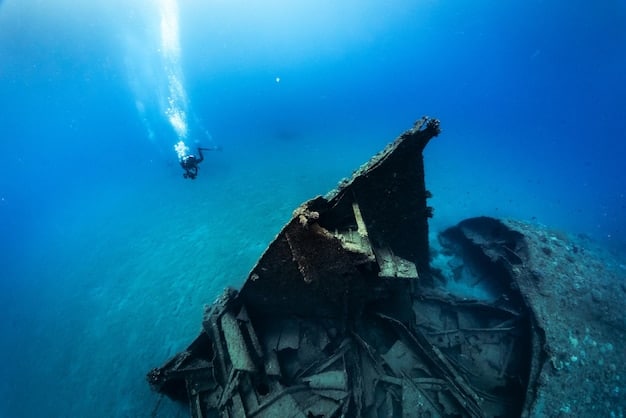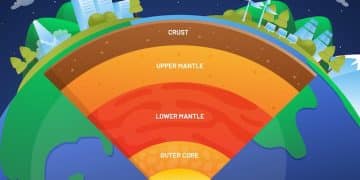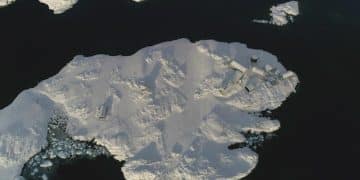Ocean Acidification: Marine Life Impacts & Mitigation

Advertisements
Ocean acidification, primarily driven by the absorption of excess atmospheric carbon dioxide, significantly impacts marine ecosystems by reducing seawater pH, threatening the survival of calcifying organisms, disrupting food webs, and ultimately diminishing biodiversity and the vital services oceans provide.
Advertisements
The vast, blue expanse of our oceans, teeming with an incredible diversity of life, seems boundless and resilient. Yet, beneath their surface, an insidious change is underway, often unseen but with profound implications: ocean acidification: how is it affecting marine life and what can we do to mitigate the effects? This critical environmental challenge, directly linked to human activity, is subtly altering the fundamental chemistry of seawater, imperiling creatures from microscopic plankton to towering corals, and posing a serious threat to the intricate balance of marine ecosystems worldwide.
Understanding ocean acidification: the basic chemistry
Ocean acidification refers to the ongoing decrease in the pH of the Earth’s oceans, caused by the uptake of anthropogenic carbon dioxide (CO2) from the atmosphere. Since the industrial revolution, human activities, primarily the burning of fossil fuels and deforestation, have released unprecedented amounts of CO2 into the atmosphere.
Advertisements
A significant portion of this excess CO2, roughly one-quarter, is absorbed by the world’s oceans. While this absorption helps to temper the rate of atmospheric warming, it comes at a significant cost to marine chemistry. When CO2 dissolves in seawater, it initiates a series of chemical reactions.
The chemical cascade
This process begins with the formation of carbonic acid (H2CO3):
- Carbon dioxide (CO2) + Water (H2O) ⇌ Carbonic acid (H2CO3)
- Carbonic acid then quickly dissociates, releasing hydrogen ions (H+) and bicarbonate ions (HCO3-).
- The release of these extra hydrogen ions is what directly increases the acidity of the seawater, which is measured on the pH scale. A lower pH indicates higher acidity.
Moreover, some of these excess hydrogen ions react with carbonate ions (CO32-), which are naturally present in seawater and are crucial building blocks for many marine organisms. They combine to form more bicarbonate ions. This reduction in the availability of carbonate ions is particularly problematic for organisms that need them to build their shells and skeletons.
Scientists estimate that the average pH of the ocean surface has already dropped by about 0.1 pH units since pre-industrial times, from approximately 8.2 to 8.1. While this change might seem small on a logarithmic scale, it represents a substantial 30% increase in ocean acidity. This rapid shift is occurring at a rate far exceeding anything seen in millions of years, leaving marine life with little time to adapt.
The implications of this fundamental chemical alteration ripple through the entire marine food web, affecting everything from the foundational microscopic life to the largest predators. Understanding this basic chemistry is the first step in appreciating the complex challenges that ocean acidification presents to our global marine ecosystems.
Impacts on marine life: the biological fallout
The altered ocean chemistry due to acidification poses an existential threat to a vast array of marine organisms, with effects cascading through entire ecosystems. The most immediate and widely studied impact is on calcifying organisms—those that build their shells and skeletons from calcium carbonate.
Key among these are corals, shellfish, and plankton. Corals, the architects of vibrant coral reefs, are particularly vulnerable. Acidic waters make it harder for them to extract carbonate ions, slowing their growth and even leading to dissolution of existing structures. This phenomenon, often referred to as “coral osteoporosis,” weakens the very framework of these critical ecosystems, which provide habitat for a quarter of all marine species.
Shellfish and plankton at risk
- Shellfish: Oysters, clams, sea urchins, and other mollusks face significant challenges. Larval stages are especially susceptible, as they struggle to form their initial shells in more acidic conditions. This impacts aquaculture and wild populations alike.
- Plankton: Pteropods, also known as “sea butterflies,” are tiny, free-swimming snails that form calcium carbonate shells. They are a vital food source for many species, from krill to whales. Acidification can dissolve their delicate shells, threatening their survival and, consequently, the entire food web that depends on them. Similarly, some types of phytoplankton, while not directly calcifying, are also sensitive to pH changes.
Beyond calcification, ocean acidification can have a range of sub-lethal effects on marine life. Studies have shown altered behaviors in fish, such as impaired senses of smell and hearing, making them less able to detect predators or find suitable habitats. For example, some fish species lose their ability to detect predator cues in more acidic water, potentially making them easier prey.
Reproduction and growth rates can also be negatively affected across various species. The disruption of these fundamental biological processes weakens populations, making them less resilient to other environmental stressors like warming waters, pollution, and overfishing. The cumulative effect is a reduction in biodiversity and a potential collapse of marine ecosystems as we know them.
The intricate web of life in the ocean is highly interconnected. The decline of one calcifying species, like pteropods, can have a ripple effect, impacting higher trophic levels and potentially leading to widespread ecosystem destabilization. The long-term consequences of these biological fallouts are still being fully understood, but the scientific consensus points to a future ocean far less hospitable to the diverse life it currently sustains.
Ecosystem-wide implications and human connections
The biological impacts of ocean acidification don’t exist in isolation; they resonate throughout entire marine ecosystems, ultimately affecting human societies that depend on healthy oceans. Coral reefs, for instance, are not merely beautiful underwater gardens; they are critical nurseries for fish, provide coastal protection from storms, and support vast tourism industries.
As acidification weakens coral structures, these ecosystem services are diminished. Coastlines become more vulnerable to erosion and storm surges without the natural buffer of reefs. Fish populations decline, impacting commercial and recreational fisheries that are vital for food security and livelihoods in many regions. The economic cost of these impacts is projected to be enormous, affecting coastal communities, reliant industries, and global food supply chains.
Food security and economic impact
- Fisheries: Many commercially important species, such as oysters, scallops, and crab, are highly susceptible to ocean acidification. Reduced populations directly threaten the fishing industry, leading to job losses and increased seafood prices.
- Tourism: The degradation of coral reefs directly impacts dive tourism and other ocean-related recreational activities, affecting local economies that depend on healthy marine environments to attract visitors.
The cascading effects extend beyond the directly impacted species. For example, the decline of pteropods, a keystone species in many polar and subpolar food webs, could severely impact salmon, cod, and even baleen whales, which rely on them as a primary food source. This highlights the interconnectedness of marine life and the potential for seemingly small changes at the base of the food web to have disproportionately large effects higher up.
Furthermore, the ability of oceans to absorb CO2 may decrease as they become more acidic. This could lead to a positive feedback loop, where less CO2 absorption by the oceans means more CO2 remaining in the atmosphere, exacerbating both global warming and further ocean acidification. This complex interplay underscores the urgent need for comprehensive solutions that address both climate change and ocean health.

Humans are inextricably linked to the health of our oceans. From the air we breathe to the food we eat, marine ecosystems provide irreplaceable services. The trajectory of ocean acidification signals a profound disruption to these services, necessitating a global, collaborative response to safeguard both marine life and human well-being for future generations. Recognizing these far-reaching implications is crucial for motivating decisive action.
Mitigation strategies: addressing the root cause
Addressing ocean acidification primarily means tackling its root cause: the excessive emissions of carbon dioxide into the atmosphere. The most effective and fundamental mitigation strategy is to drastically reduce global CO2 emissions from human activities. This involves a multifaceted approach encompassing shifts in energy production, transportation, industry, and land use.
Transitioning from fossil fuels to renewable energy sources like solar, wind, hydropower, and geothermal is paramount. This requires massive investments in infrastructure, technological innovation, and policy frameworks that incentivize cleaner energy production and consumption. Phasing out coal-fired power plants and replacing them with sustainable alternatives would significantly curb a major source of CO2 emissions.
Reducing carbon footprints
- Energy Efficiency: Improving energy efficiency in homes, businesses, and transportation can significantly reduce overall energy demand and, consequently, CO2 emissions.
- Sustainable Transportation: Promoting electric vehicles, public transportation, cycling, and walking can reduce emissions from the transport sector.
- Industrial Decarbonization: Implementing carbon capture and storage technologies, and developing more sustainable industrial processes can lower emissions from heavy industries.
Beyond energy, sustainable land management practices play a crucial role. Deforestation releases stored carbon into the atmosphere, so efforts to protect existing forests and embark on large-scale reforestation and afforestation initiatives are vital. Healthy forests act as carbon sinks, absorbing CO2 from the atmosphere.
Furthermore, agricultural practices can be adapted to reduce emissions. Improved soil management, reduced use of nitrogen fertilizers, and sustainable livestock farming can contribute to a lower carbon footprint. Policy instruments such as carbon pricing, emissions trading schemes, and regulatory standards can provide incentives for businesses and individuals to reduce their emissions.
While the scale of global CO2 emissions is immense, the scientific consensus is clear: deep and rapid cuts are necessary to prevent the most severe consequences of ocean acidification and climate change. This requires unprecedented international cooperation, technological deployment, and a collective commitment to a low-carbon future. Mitigating ocean acidification at its source is not just an environmental imperative; it’s an economic and social one, safeguarding the future of our planet and its resources.
Adaptation and local interventions
Beyond global CO2 reductions, which are essential long-term solutions, there are also various adaptation strategies and local interventions that can help marine ecosystems and communities cope with the ongoing impacts of ocean acidification. While these do not solve the root problem, they can buy time and enhance resilience in vulnerable areas.
One key approach is to reduce other local stressors on marine ecosystems. Overfishing, pollution (from agriculture, sewage, and plastics), and coastal development weaken ecosystems, making them more susceptible to the effects of acidification. By improving water quality, establishing marine protected areas, and implementing sustainable fishing practices, we can create healthier, more resilient environments. For example, reducing nutrient runoff can help prevent harmful algal blooms, which exacerbate local acidification.
Building resilience through selective breeding and restoration
- Selective Breeding: Scientists are exploring selective breeding programs for calcifying organisms, such as oysters and corals, to identify and cultivate varieties that are more tolerant to acidic conditions. This can help create more robust populations.
- Habitat Restoration: Restoring degraded habitats, such as oyster reefs, mangrove forests, and seagrass beds, can provide refuge for marine life and help improve local water chemistry. Seagrasses, for instance, absorb CO2 for photosynthesis, potentially reducing acidity in their immediate vicinity.
Geoengineering approaches are also being explored, though they remain highly controversial and largely unproven at scale due to potential unintended consequences. These include proposals to directly add alkaline substances to the ocean to counteract acidification or to enhance nutrient upwelling to stimulate phytoplankton growth, which could absorb more CO2. However, the sheer volume of ocean water makes these approaches incredibly challenging and expensive, with unknown ecological side effects.

Another area of focus is developing early warning systems and monitoring networks to track ocean chemistry changes. This data helps scientists understand localized impacts and inform adaptive management strategies. While local interventions cannot replace broad-scale CO2 reductions, they can be critical for preserving biodiversity and supporting livelihoods in the face of ongoing environmental change. They represent a vital component of a comprehensive strategy to manage the multi-faceted challenges posed by ocean acidification.
Policy, research, and public engagement
Effective action against ocean acidification requires robust policy frameworks, continued scientific research, and widespread public engagement. Governments play a crucial role in enacting legislation that mandates emissions reductions, sets environmental standards, and funds conservation initiatives. International agreements, such as the Paris Agreement, are vital for coordinating global efforts to reduce greenhouse gas emissions, though their implementation needs to be strengthened.
Policy tools can include carbon taxes, cap-and-trade systems, subsidies for renewable energy, and regulations on industrial emissions and agricultural runoff. Protecting and restoring coastal ecosystems, such as mangroves and seagrass beds, can also be supported through national and regional policies given their role in carbon sequestration and buffering local pH levels.
Advancing scientific understanding
- Research & Monitoring: Continued investment in ocean acidification research is essential to better understand its complex impacts, identify vulnerable species and ecosystems, and develop effective adaptation strategies. This includes long-term monitoring of ocean chemistry in various regions.
- Technological Innovation: Research also drives the development of new technologies for renewable energy, carbon capture, and sustainable aquaculture, which are all part of the solution.
Public engagement and education are equally critical. Raising awareness about ocean acidification and its connection to daily choices can inspire individual actions and build pressure for political will. Education campaigns can inform consumers about sustainable seafood choices, responsible tourism, and the importance of reducing personal carbon footprints. Citizen science initiatives can also contribute valuable data and foster a sense of stewardship.
Journalists, educators, and community leaders have a vital role in communicating the urgency and complexity of ocean acidification in an accessible manner. By fostering a deeper understanding of this issue, they can help translate scientific findings into actionable knowledge for policymakers and the general public. Ultimately, a combined approach of strong policy, cutting-edge research, and an informed, engaged populace is necessary to safeguard our oceans from the accelerating threat of acidification.
The path forward: collective action for ocean health
The challenge of ocean acidification is immense, interwoven with the broader issue of climate change, and demands a comprehensive and collaborative response. There is no single silver bullet; rather, a concerted effort across multiple scales—global, national, local, and individual—is required to mitigate its effects and protect marine life.
At the global level, the most significant action remains the rapid and substantial reduction of greenhouse gas emissions. This means a rapid transition away from fossil fuels, significant investments in renewable energy, and improved energy efficiency worldwide. International agreements must be strengthened and rigorously implemented, with nations holding each other accountable for emission reduction targets.
On a national and regional scale, governments, industries, and communities must implement policies that support decarbonization and ecosystem resilience. This includes fostering innovation in green technologies, protecting critical marine habitats through marine protected areas, regulating pollution, and supporting sustainable fisheries and aquaculture practices that can adapt to changing ocean conditions.
Local actions, though seemingly small, collectively make a difference. Individuals can reduce their carbon footprint by conserving energy, choosing sustainable transportation, and supporting businesses committed to environmental responsibility. Educating oneself and others about ocean acidification and its wider implications is also a powerful form of advocacy. Supporting scientific research and conservation organizations through donations or volunteering helps advance our understanding and ability to respond.
Furthermore, fostering a greater connection between humanity and the ocean is crucial. Recognizing the ocean not just as a resource, but as a living system essential for all life on Earth, can inspire a deeper sense of responsibility and urgency. Collaboration among scientists, policymakers, industry leaders, environmental groups, and communities is fundamental to translating knowledge into effective solutions.
The future of our oceans, and by extension, our planet, hinges on the collective decisions we make today. While the scale of the problem can seem daunting, every action, big or small, contributes to building a more resilient ocean and a sustainable future.
| Key Point | Brief Description |
|---|---|
| 🌊 Ocean Chemistry | Oceans absorb excess CO2, leading to increased acidity (lower pH) and reduced carbonate ions. |
| 🐚 Marine Life Impacts | Threatens calcifying organisms (e.g., corals, shellfish, pteropods) and alters fish behavior. |
| 🌍 Ecosystem & Human Toll | Degrades coral reefs, impacts fisheries, and threatens coastal protection and biodiversity. |
| 🛠️ Mitigation & Adaptation | Reduce CO2 emissions, reduce local stressors, and support research and sustainable practices. |
Frequently asked questions about ocean acidification
▼
Ocean acidification is primarily caused by the absorption of excess carbon dioxide (CO2) from the Earth’s atmosphere into the oceans. This CO2 largely originates from human activities such as the burning of fossil fuels, deforestation, and industrial processes. When CO2 dissolves in seawater, it forms carbonic acid, which then releases hydrogen ions, increasing the water’s acidity and lowering its pH.
▼
Calcifying organisms are most vulnerable, as their ability to build shells and skeletons from calcium carbonate is inhibited. This includes corals, shellfish like oysters and clams, and microscopic plankton such as pteropods. Fish can also experience impaired senses (smell, hearing), affecting their ability to find food, mates, or avoid predators. These impacts ripple through entire marine food webs.
▼
Ocean acidification significantly impedes the ability of corals to grow and repair their calcium carbonate skeletons. As the water becomes more acidic and carbonate ions become less available, corals grow more slowly, become weaker, and can even begin to dissolve. This weakens the structural integrity of coral reefs, which provide critical habitat for countless marine species and protect coastlines.
▼
The most effective strategy is a substantial reduction in global carbon dioxide emissions. This involves transitioning to renewable energy sources (solar, wind), improving energy efficiency, and adopting sustainable land management practices like reforestation. Local mitigation efforts can include reducing other marine stressors like pollution and overfishing, and localized habitat restoration to enhance resilience.
▼
While ocean acidification is a global issue requiring large-scale solutions, individual actions contribute to the collective effort. Reducing your personal carbon footprint (e.g., through energy conservation, sustainable transport), supporting renewable energy, making informed consumer choices (e.g., sustainable seafood), and advocating for strong environmental policies all play a role in mitigating the problem and raising awareness within communities and beyond.
Conclusion
The silent, subtle shift in ocean chemistry, known as ocean acidification, stands as one of the most pressing environmental challenges of our time. Its profound and far-reaching impacts on marine life, from the smallest calcifying organisms to the largest marine ecosystems, underscore the interconnectedness of our planet. As we have explored, the very foundation of marine food webs is at risk, threatening biodiversity, essential ecosystem services, and human livelihoods. Addressing this crisis necessitates an urgent and comprehensive global response, primarily centered on drastically reducing carbon dioxide emissions. Collaborative efforts across governments, industries, scientific communities, and individuals are essential, as is fostering a deeper appreciation for the delicate balance of our oceans. The path forward demands sustained commitment to scientific research, innovative policy, and collective action, ensuring that the vibrant, life-sustaining essence of our oceans endures for generations to come.





